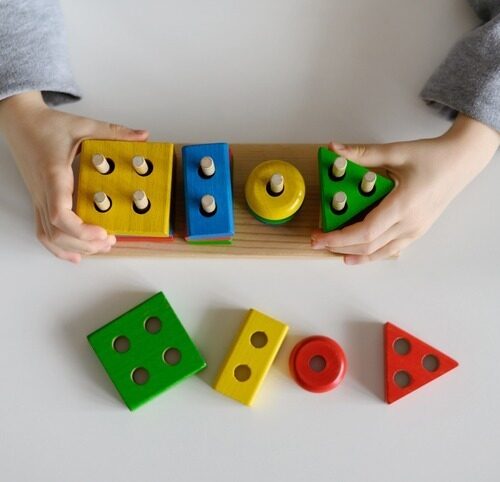Once upon a time, toy stores decided what lined the shelves and, in turn, what kids begged their parents for. Not anymore. Social media can turn an obscure plush toy into a global obsession overnight, artificial intelligence is blurring the line between play and companionship, and a new wave of adult collectors is redefining what it means to be a toy brand. The business of play has become an unpredictable, high-stakes competition where the next blockbuster toy could come from anywhere.
Worth over $108 billion, the global toy market isn’t slowing down – it’s evolving. Consumers aren’t just looking for play; they’re looking for connection, creativity, and collectibility. AI-powered toys that respond like real companions, nostalgia-packed reboots, and digital-physical hybrids are shaking up the industry, forcing brands to rethink the blueprint of a best-seller.
Toymakers like LEGO, Mattel, and Hasbro are investing in research and development to stay ahead. China’s manufacturers continue to dominate global production, while Southeast Asia emerges as a critical growth market. With trends evolving at breakneck speed, the question is no longer what toys will sell – but whether the industry can keep up.
The Changing Landscape of Play
Play isn’t what it used to be. Digital integration, evolving consumer expectations, and economic shifts are rewriting the rules of the toy industry. Parents want learning-driven play, kids expect toys to be interactive, and adult collectors are looking for nostalgia with a premium twist. The result? A market where toys aren’t just for fun – they’re tools for education, identity, and connection.
In the US and the UK, STEM and educational toys are becoming increasingly popular as parents prioritise learning through play. Products that incorporate coding, robotics, and problem-solving are seeing sustained demand. According to NPD Group, STEM toy sales in the US increased by 12% in 2023, reflecting a shift toward playthings that provide both engagement and developmental benefits.
Regional Consumer Behaviour Shifts
Asia’s toy market tells a different story.
In China and Japan, AI-driven toys and collectibles dominate the market. Companies like Tencent and Bandai Namco are integrating artificial intelligence into toys, creating interactive play experiences that appeal to both children and collectors. Smart robots, augmented reality-enhanced games, and anime-inspired figurines are key drivers of growth.
In India and Southeast Asia, a rising middle class is reshaping the toy market. Parents are spending more on aspirational and interactive toys, while kids gravitate toward licensed character merchandise and gaming tie-ins. In Indonesia, the Philippines, and Vietnam, affordability still matters, but innovation is the real differentiator.
For toymakers, success now hinges on understanding how culture, technology, and demographics intersect. A strategy that works in China may flop in Europe, while trends that take off in the US might struggle in Southeast Asia. The challenge isn’t just innovation – it’s adaptation.
Tech-Infused Toys Are Winning Big
AI-driven toys aren’t the future – they’re already here. From machine-learning-powered companions to AR-enhanced board games, brands are embedding intelligence into play. With the AI toy market set to grow at 5.8% CAGR through 2032, the industry isn’t just selling toys—it’s building interactive, evolving experiences.
Image credit: Cozmo
In the US and UK, AI-powered toys like Cozmo and Osmo have redefined interactive learning. Parents looking for more than screen time are embracing smart toys that adapt to their children’s behaviour, respond to voice commands, and integrate with tablets. As demand grows, companies are pushing the boundaries – introducing AI companions that recognise emotions, refine speech patterns, and even mimic human-like interactions.
Beyond AI, gamification is increasingly influencing toy design. The runaway success of Roblox and Minecraft has driven demand for physical collectibles linked to digital worlds. Companies have responded with action figures, buildable sets, and interactive board games that mimic the mechanics of their online counterparts. LEGO’s partnership with Minecraft and Hasbro’s integration of video game IP into its toy lines illustrate how brands are leveraging gaming culture to drive toy sales.
Southeast Asia has embraced a hybrid play model that combines digital and physical engagement. In Indonesia and Thailand, interactive toys that connect to mobile apps, feature augmented reality components, or incorporate motion-tracking technology are gaining traction. This preference aligns with the region’s broader digital adoption trends, where mobile gaming and social media heavily influence consumer behaviour.
For toy companies, innovation comes with trade-offs. Smart toys promise engagement, but privacy concerns linger as parents question how much data these products collect. Cost is another barrier – AI-powered toys often come with premium price tags, making them inaccessible in price-sensitive markets. Despite these hurdles, the shift toward intelligent play is no longer a question of if but how fast it will reshape the industry.
The Nostalgia Effect and the Rebirth of Classic Play
Familiar brands and characters from the past are making a comeback, fueled by a wave of nostalgia-driven consumer demand. Millennials and Gen Z, now parents themselves, are revisiting the toys of their childhood, creating a lucrative market for reissued classics. This trend has translated into strong sales for legacy brands, with LEGO reporting a 13 percent increase in revenue in the first half of 2024 as collectors and new generations embrace its timeless appeal.
The revival is not limited to building blocks. Pokémon, a franchise that has remained a cultural force for nearly three decades, continues to generate billions in merchandise sales, fueled by video game releases, trading cards, and animated series. The brand’s ability to reinvent itself while maintaining core elements from the 1990s has made it a model for sustained success in the nostalgia economy.
Mattel is leading the nostalgia boom, with its classic Barbie relaunch driving a 15 percent surge in shares as both collectors and new audiences embrace retro-inspired designs. The company is applying the same strategy to other legacy brands, reviving Masters of the Universe and Hot Wheels to appeal to the generation that grew up with them.
The trend is not confined to Western markets. In China and the Philippines, anime-inspired toys are experiencing a surge in demand, blending nostalgia with contemporary culture. Figures and collectibles from franchises like One Piece, Naruto, and Demon Slayer have become staples in the growing adult collector market, as well as among younger fans introduced to these series through streaming platforms. Japanese manufacturers such as Bandai Namco are expanding their presence in Southeast Asia, recognising the strong appetite for licensed merchandise tied to classic anime and gaming properties.
Nostalgia may be a powerful sales driver, but it’s not a guaranteed long-term strategy. Toy companies are walking a fine line between reviving past hits and keeping them relevant for new audiences. Limited-edition releases, premium collector sets, and digital tie-ins have kept engagement high, but sustaining demand beyond the initial hype is the real challenge. Longevity will depend on brands treating nostalgia as a launchpad for innovation, not a safety net for sales.
The Rise of the Kidult Toy Market
Once dismissed as a niche segment, adult toy collectors have become one of the fastest-growing consumer groups in the industry. The so-called “kidult” market – comprising Millennials and Gen Z buyers – now accounts for 17.3 percent of total toy sales, totaling $6.7 billion in 2023. This group is drawn to high-end collectibles, action figures, and designer toys, driving demand for premium releases and limited-edition runs.
Toy companies are no longer designing just for kids. LEGO’s “Adults Welcome” line, which includes intricate builds inspired by art, architecture, and pop culture, has become a major revenue driver, proving nostalgia isn’t the only force at play. Brands are tapping into fandom culture, gaming, and premium craftsmanship to cater to a generation that sees toys as collectibles, investments, and expressions of identity.
Key Market Drivers
In the US and UK, adult collectors are gravitating toward franchises with decades-long legacies. Star Wars, Marvel, and DC Comics remain dominant, with high-end action figures, replica weapons, and limited-edition statues driving a significant portion of sales. Hasbro’s Black Series and Marvel Legends lines, along with premium models from Hot Toys and Sideshow Collectibles, cater specifically to this market.
Anime culture has transformed China and Japan into powerhouses of the global collectibles market. Gundam models, capsule toys, and figurines from series like Demon Slayer, One Piece, and Mobile Suit Gundam are more than just fan memorabilia – they are billion-dollar businesses. Bandai Namco has perfected the art of scarcity, releasing high-value limited editions that disappear from shelves within minutes. Meanwhile, Tokyo’s Akihabara district and China’s expanding anime-themed retail hubs have taken these collectibles from niche subcultures to mainstream must-haves.
K-pop and gaming culture are fueling the growth of the adult toy market in Indonesia and the Philippines. Limited-edition BTS figurines, NCT-inspired dolls, and League of Legends character statues have become status symbols among fans, selling out as soon as they launch. The booming esports scene is further driving demand for high-end gaming merchandise, from custom controllers to exclusive collectibles tied to top franchises.
Industry Response
Toy companies are racing to meet the demand of deep-pocketed adult collectors. Bandai Namco has doubled down on premium anime figurines, crafting meticulously detailed, limited-edition statues that fans snap up instantly. Meanwhile, Mattel and Hasbro are reviving 1980s and 1990s classics, upgrading them with better materials and exclusive accessories to appeal to buyers who want nostalgia without compromise.
The rise of the kidult market has forced toy companies to rethink their core audience. While younger buyers still expect affordability, adult collectors are willing to pay premium prices for exclusivity. With some spending thousands on rare or custom-made pieces, the line between toys and luxury collectibles is blurring, reshaping the economics of play.
Sustainability and the Ethical Consumer Push
Sustainability has gone from a talking point to a business imperative. With growing concerns over plastic waste, consumers are demanding greener alternatives, pushing brands to rethink how toys are made, packaged, and distributed. In Japan, Singapore, and Europe, biodegradable and plastic-free options are gaining traction, forcing manufacturers to align with rising environmental expectations beyond just product design.
In the UK, affordability is shaping the sustainability trend in unexpected ways. Parents are fueling demand for “pocket money” toys under £10, balancing eco-conscious choices with budget constraints. While this shift has encouraged some manufacturers to develop small, sustainable items, it has also kept cheaper plastic-based toys on store shelves, highlighting the cost challenge of going green.
Marketing Challenges
The push for sustainable toys comes with a cost – literally. Many eco-friendly options are priced higher, limiting accessibility for budget-conscious consumers. While wealthier households in developed markets may embrace sustainability, most parents still choose affordability over ethics. For toy brands, the real challenge isn’t just making greener products, but doing so at a price families can afford.
Skepticism is another roadblock. As sustainability becomes a selling point, brands face increasing scrutiny over greenwashing – promoting eco-friendly claims without real substance. Nowhere is this more evident than in Europe, where regulators are cracking down on misleading eco-labels. To earn consumer trust, companies must go beyond buzzwords, proving their environmental commitments with transparent sourcing, independent certifications, and tangible action.
Challenges aside, sustainability is no longer a trend – it’s a transformation. Toy companies are testing recycled plastics, bio-based materials, and circular economy models, but the real question is whether green toys will remain a niche or become the new industry standard.
Asia’s Influence on Global Toy Trends
Asia isn’t just the world’s toy factory – it’s shaping what kids and collectors want to buy. China leads in production, Japan dominates collectibles, and India is rising as a manufacturing force, ensuring the region’s influence extends far beyond supply chains.
China produces 70 percent of the world’s toys, but its influence doesn’t stop at manufacturing. Homegrown franchises like Honor of Kings are gaining traction beyond Chinese borders, showing that China isn’t just making toys – it’s shaping global trends.
Japan’s role in the toy industry has been driven by its influence on storytelling and collector culture. With anime remaining one of the country’s most successful cultural exports, franchises such as Demon Slayer and One Piece have become global bestsellers, generating billions in toy-related revenue. Japanese manufacturers, particularly Bandai Namco, have built an industry around high-value collectibles, catering to a growing global market of adult fans who see figures, model kits, and capsule toys as investments rather than simple playthings. The company’s expansion into international markets has reinforced Japan’s status as a leader in character-driven collectibles.
India is carving out its own space in the toy industry – not as a collector’s hub, but as a manufacturing force. Government incentives are fueling domestic production, allowing local brands to compete in the mass-market segment. The shift toward self-sufficiency is not just about serving Indian consumers; it’s also creating export opportunities for countries seeking alternatives to Chinese manufacturing.
Asia’s toy industry is no longer just about production – it’s shaping what the world plays with. Homegrown franchises are going global, anime-driven merchandising is thriving, and new manufacturing hubs are changing the industry’s balance of power.
The Wild Cards That Could Shape the Next Craze
The next breakout toy won’t be decided by boardroom strategists – it’ll be made viral overnight. Social media, entertainment tie-ins, and influencers now shape demand, leaving toymakers scrambling to keep up. In a world where trends can disappear as quickly as they explode, agility is the only way to stay relevant.
A viral video can turn an overlooked toy into the next global must-have. TikTok and Instagram have made sensations out of fidget toys, collectible mini brands, and unboxing sets, with demand surging in hours. But the real shift isn’t just in what’s trending—it’s who controls the trend. Today, consumers, not toy companies, dictate demand.
Hollywood isn’t just creating movies and shows – it’s fueling the toy industry. Blockbuster releases like Captain America: Brave New World and The Fantastic Four: First Steps are expected to drive massive toy sales in 2025, as brands tap into built-in fan bases (Licensing International, 2024). But the real game-changer is streaming. Binge-watching keeps franchises relevant long after their theatrical run, turning series like Stranger Things, The Mandalorian, and Wednesday into merchandising goldmines.
Influencers have become kingmakers in the toy industry, turning niche products into overnight sellouts. YouTube personalities and TikTok creators now dictate demand, with exclusive toy collaborations disappearing from shelves within hours. But today’s consumers – especially parents – are savvier than ever. Authenticity matters, and brands that treat influencers as scripted salespeople risk losing trust.
The next toy craze won’t be meticulously planned – it’ll erupt online when no one sees it coming. In a market where trends explode overnight, the brands that thrive will be the ones that react fast, fuel digital momentum, and secure key partnerships before the hype disappears.
Most Popular Toys Around the World (2025)
| Country | Most Popular Toy | Notes |
| United States | STEM and educational toys (Osmo, LEGO robotics) | Parents prioritise learning-based toys, driving demand for coding and robotics kits. |
| United Kingdom | Pocket money toys and retro collectibles (Mini Brands, Pokémon cards) | Small, affordable toys under £10 are trending, along with nostalgia-driven collectibles. |
| China | AI-driven smart toys and Honor of Kings figures | AI-powered companions and gaming-inspired collectibles dominate the market. |
| India | Educational and aspirational toys (building sets, locally made interactive toys) | Rising middle-class demand for innovative, skill-building toys. |
| Indonesia | K-pop and gaming collectibles (BTS figurines, League of Legends statues) | The intersection of fandom and collectibles drives strong sales. |
| Philippines | Anime-inspired figures and gaming toys (One Piece, Funko Pop) | Strong influence from anime and gaming culture, with high demand for imported merchandise. |
| Singapore | Sustainability-focused toys (biodegradable wooden toys, modular playsets) | Growing preference for eco-friendly materials and multifunctional designs. |
| Japan | Gundam models and capsule toys | The adult collector market continues to expand, fueled by anime franchises. |
| Thailand | Augmented reality playsets and interactive board games | Digital-meets-physical toys are thriving as mobile gaming influences traditional play. |
| Vietnam | Affordable interactive toys | A growing middle class is driving demand for interactive yet cost-effective play experiences. |
| Germany | Playmobil and STEM toys | Playmobil remains a favorite, with an increasing focus on educational themes. |
| France | Classic wooden toys and Sophie la Girafe | Parents favor high-quality, traditional playthings with an emphasis on safety and sustainability. |
| Spain | Scalextric slot car racing sets | Classic racing sets remain popular among hobbyists and younger audiences. |
| Italy | Skydancers and fashion dolls | A resurgence of nostalgic toy brands alongside new interactive dolls. |
| Brazil | Barbie and superhero action figures | Traditional toy categories remain strong, with a growing interest in branded character toys. |
| Argentina | PlayStation 4 and affordable gaming accessories | Economic constraints drive demand for previous-generation consoles and budget-friendly gaming peripherals. |
| Chile | LEGO and STEM-based play kits | A push for educational toys mirrors global trends toward learning-focused play. |
| Colombia | Funko Pop and collectible figurines | The adult collector market is growing, driven by pop culture fandoms. |
| Australia | LEGO and pop culture board games | Board games inspired by movies, TV series, and video games are gaining popularity. |
| Malaysia | L.O.L. Surprise! Dolls and smart toys | The combination of unboxing trends and tech-infused play drives sales. |
What Comes Next for Toy Brands
The most successful toy brands will be those that balance innovation with familiarity. While AI, augmented reality, and smart play are reshaping the market, the demand for tactile, imaginative, and nostalgia-driven toys isn’t fading. The companies that win the future won’t just embrace technology – they’ll weave it into storytelling, blend education with entertainment, and make sustainability accessible rather than aspirational.
Toy brands can no longer take a one-size-fits-all approach. In the US and China, AI-powered and tech-driven toys are poised to dominate sales, while in Europe and Southeast Asia, eco-friendly and educational toys are gaining momentum as parents prioritise sustainability and developmental value. Companies that fail to adapt to these shifting preferences risk fading into irrelevance.
Sustainability is no longer optional – it’s an industry expectation. As consumers become more conscious of plastic waste and ethical production, brands investing in biodegradable materials, modular designs, and circular economy initiatives will gain long-term trust. What was once a niche selling point is now a competitive necessity.
For toy brands, the real challenge isn’t just innovation – it’s keeping up. Trends can explode overnight, social media now dictates demand, and licensing deals can make or break annual sales. According to industry analyst Susan Murphy, “The future of the toy industry lies in its ability to innovate while staying true to the fundamental principles of play. Companies that can adapt to changing consumer behaviours without losing sight of the joy that toys bring will lead the next big craze.
The brands that thrive won’t just chase trends – they’ll anticipate them. AI-powered companions, nostalgia-driven revivals, and sustainability-led innovation will define the industry’s next era. But the real power will belong to the toymakers who don’t just track what’s trending – but understand why it matters.
Get regular insights
Keep up to date with the latest insights from our research as well as all our company news in our free monthly newsletter.





 Senior Marketing Executive
Senior Marketing Executive Sales & Marketing
Sales & Marketing General Manager PR -Internal Communications & Government Affairs
General Manager PR -Internal Communications & Government Affairs Vital Strategies
Vital Strategies
 Customer Intelligence Director
Customer Intelligence Director